 Leather Shoe – 5,500 years old
Leather Shoe – 5,500 years old
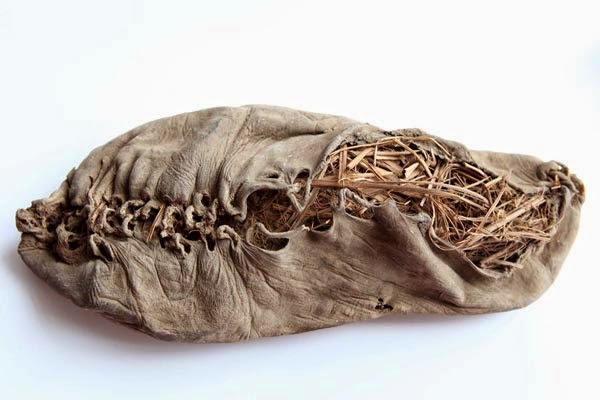 A perfectly preserved shoe, 1,000 years older than the Great Pyramid of Giza in Egypt and 400 years older than Stonehenge in the UK, has been found in a cave in Armenia. The 5,500 year old shoe, the oldest leather shoe in the world, is made from a single piece of cowhide, cut into two layers, tanned and laced. It contained grass, although the archaeologists were uncertain as to whether this was to keep the foot warm or to maintain the shape of the shoe. “It is not known whether the shoe belonged to a man or woman,” said lead author of the research “We thought initially that the shoe and other objects were about 600-700 years old because they were in such good condition,” said Dr Pinhasi. “It was only when the material was dated by the two radiocarbon laboratories in Oxford, UK, and in California, US that we realised that the shoe was older by a few hundred years than the shoes worn by Ötzi, the Iceman.” Three samples were taken in order to determine the absolute age of the shoe and all three tests produced the same results. Interestingly enough the shoe very much resembles a traditional Armenian shoe known as “charokh” a type of moccasin, still in popular use in Armenia.
A perfectly preserved shoe, 1,000 years older than the Great Pyramid of Giza in Egypt and 400 years older than Stonehenge in the UK, has been found in a cave in Armenia. The 5,500 year old shoe, the oldest leather shoe in the world, is made from a single piece of cowhide, cut into two layers, tanned and laced. It contained grass, although the archaeologists were uncertain as to whether this was to keep the foot warm or to maintain the shape of the shoe. “It is not known whether the shoe belonged to a man or woman,” said lead author of the research “We thought initially that the shoe and other objects were about 600-700 years old because they were in such good condition,” said Dr Pinhasi. “It was only when the material was dated by the two radiocarbon laboratories in Oxford, UK, and in California, US that we realised that the shoe was older by a few hundred years than the shoes worn by Ötzi, the Iceman.” Three samples were taken in order to determine the absolute age of the shoe and all three tests produced the same results. Interestingly enough the shoe very much resembles a traditional Armenian shoe known as “charokh” a type of moccasin, still in popular use in Armenia.
Source: http://www.sciencedaily.com/releases/2010/06/100609201426.htm
 Sky Observatory – 7,500 years old
Sky Observatory – 7,500 years old
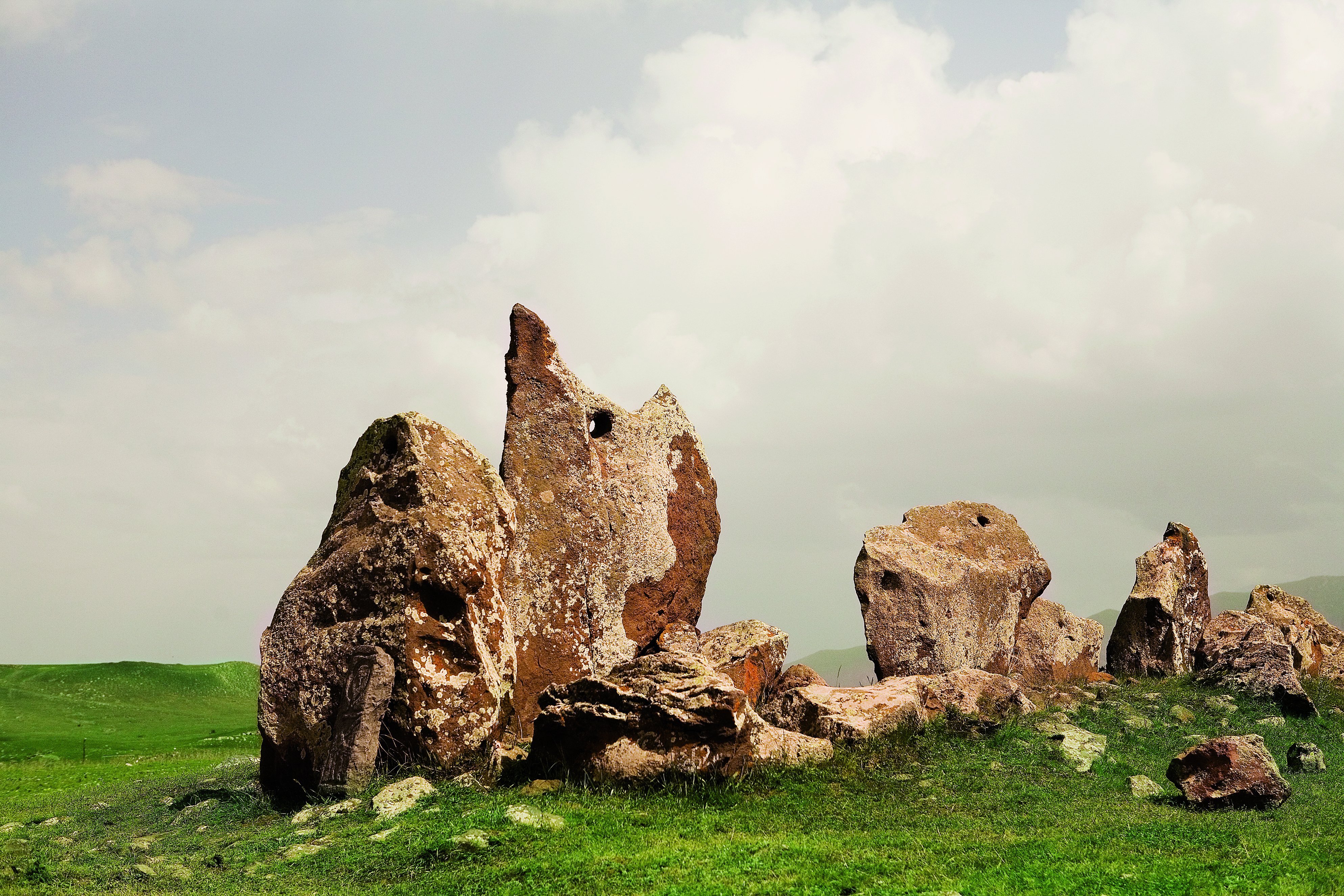
Source: http://www.aras.am/Archaeoastronomy/astronomyancientarmenia.html
 Human Brain – 6,000 years old
Human Brain – 6,000 years old

Source: http://www.popsci.com/scitech/article/2009-01/archeologists-unearth-oldest-old-world-brain

 Wagons – 4,000 years old
Wagons – 4,000 years old
Over a dozen rich burials have been excavated in Armenia. The most spectacular were those excavated at Lchashen on the borders of Lake Sevan where a more than a dozen almost complete four-wheeled and two wheeled wagons, as well as two wheeled chariots with spoked wheels were uncovered. Two of these wagons form a spectacular display in the National Museum in Armenia. The four solid wheels are made from three planks of oak, while the interior is covered by a covering of withies. In his chronology (Timeline of the Development of the Horse, 2007) Beverley Davis describes these wagons as follows: “Primitive wagons dating from this time (2000 BCE) have been found in excellent condition in Armenia. These are the oldest known wagons in the world.” The wagons have also been included in Prof Stuart Piggott’s classic book “The Earliest Wheeled Transport”.
Source: 1) http://www.armeniapast.com/discovering-armenia/ 2) http://sino-platonic.org/complete/spp177_horses.pdf

 Skirt – 5,900 years old
Skirt – 5,900 years old
Fragment of a skirt made of reed was found during excavations in the Areni-1 cave in southern Armenia. Pavel Avetisian, the head of the Institute of Archeology and Ethnography in Yerevan, informed that this artifact was discovered in 2010 and, even though they had informed about this precious item at the time, interest toward it grew further only recently. “The women’s clothing dates back to 39th century BC. So far we have discovered the skirt’s parts, which were superbly preserved. It is an amazing material with rhythmic color hues, and other remnants of the straw-woven material were also discovered. Such thing is recorded in Armenia for the first time,” Avetisyan noted. It’s considered the world’s oldest piece of reed clothing.
Source: http://www.huffingtonpost.com/2010/10/26/5900yearold-skirt-found-i_n_774429.html
 Wine-Making Facility – 6,100 years old
Wine-Making Facility – 6,100 years old
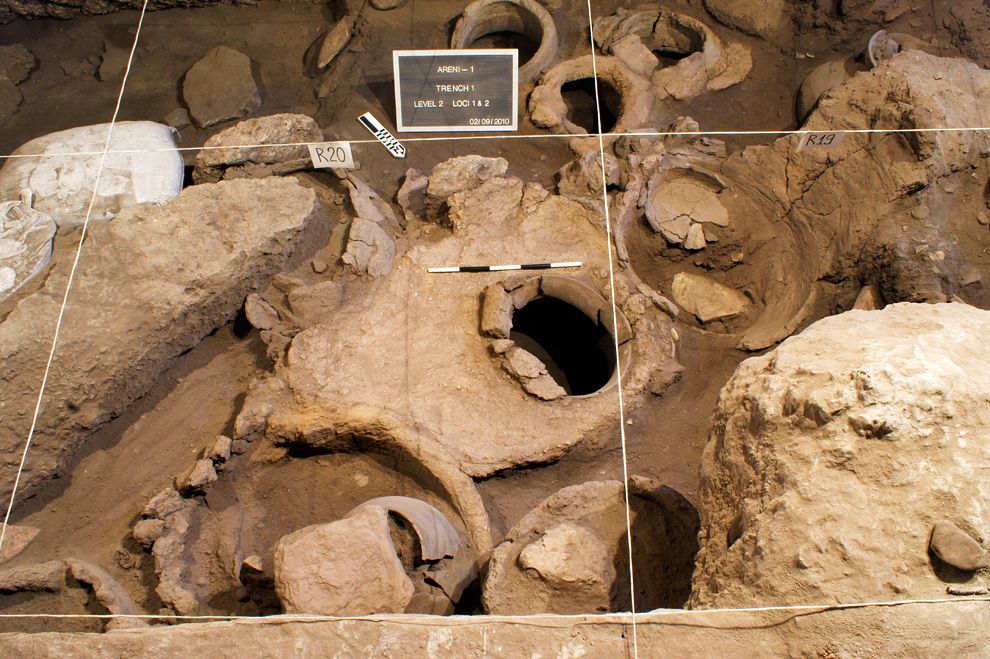
Source: 1) http://graphics8.nytimes.com/packages/pdf/science/YJASC_2685.pdf 2) http://news.nationalgeographic.com/news/2011/01/110111-oldest-wine-press-making-winery-armenia-science-ucla/
 Metal Smelting Foundry – 6,000 years old
Metal Smelting Foundry – 6,000 years old
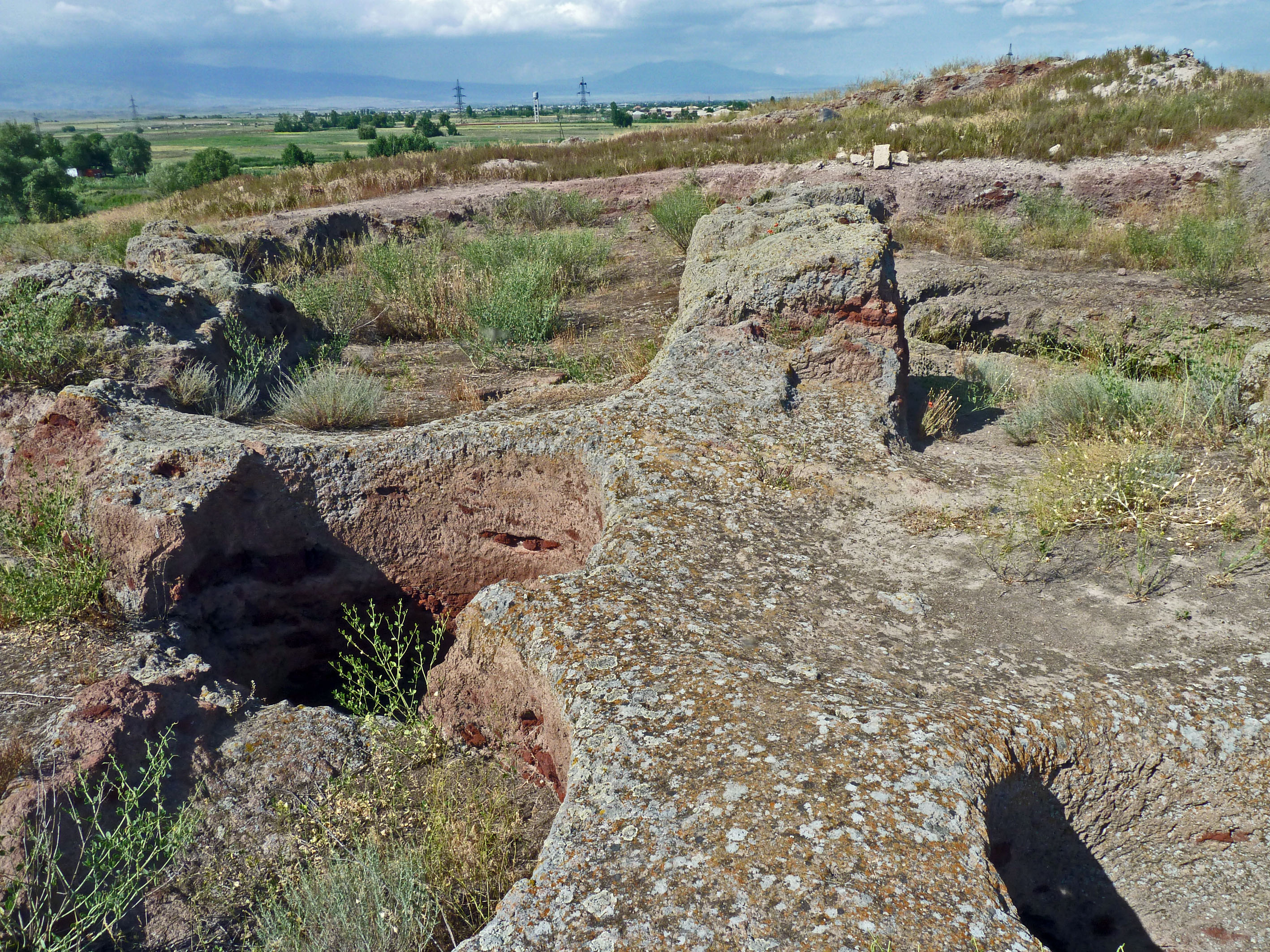
Source: http://www.ancient-wisdom.co.uk/turkeymetsamor.htm
 Innovative Stone Age Tools – 325,000 years old
Innovative Stone Age Tools – 325,000 years old
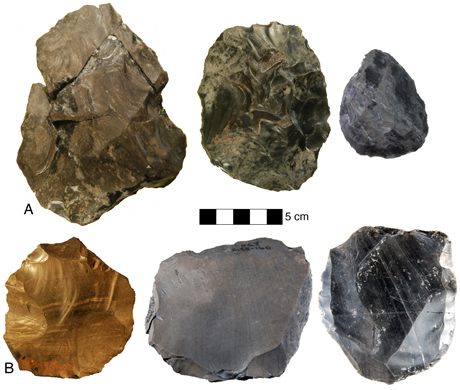
Source: 1) http://www.sciencemag.org/content/345/6204/1609 2) http://www.sciencedaily.com/releases/2014/09/140925141224.htm
 Depictions of Agriculture – 7,500 years old
Depictions of Agriculture – 7,500 years old
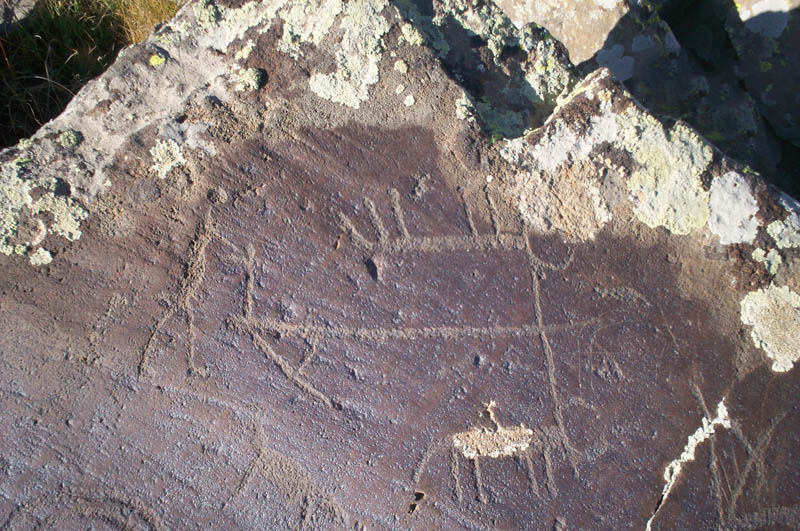
Source: 1) http://ayfwest.org/news/ughtasar-the-petroglyphs-of-armenia/ 2) http://sino-platonic.org/complete/spp177_horses.pdf

 War Horses – 4,500 years old
War Horses – 4,500 years old
Armenian archaeologists discovered an ancient burial site containing a large amount of sacrificed animal remains, among them war horses. The head of the Cultural Inheritance Research Center of Armenia Hakob Simonyan explained that the horse bones found at “Nerkin Naver” are the oldest yet uncovered belong to a domesticated horse used for military purposes. “This find dates back to the 26-25th centuries BC, and it’s the oldest burial place of a horse discovered to this day. It has an all-important significance not only for Armenia, but for the whole Western Asia as well,” Simonian said. Horse domestication and breading has for long been associated with ancient Armenia. Classical writers would often refer to Armenia as a land of excellence horse mastery. The ancient Greek historian Strabo describes Armenian war horses in several of his passages [11. 14. 9]: “Artavasdes (king of the Armenians), at the time when he invaded Media, showed, apart from the rest of the cavalry, six thousand horses drawn up in battle array covered with complete armor.” Horses have been considered sacred animals to the ancient Armenians and have been associated with the solar deity. Ancient Greek writers have equally recorded horse sacrifice in Armenia, Xenophon Anabasis [4. 5. 35] (430 – 354 BC) recounts: “Then Xenophon took the village chief back for the time to his own household, and gave him a horse that he had got when it was rather old, to fatten up and sacrifice, for he understood that it was sacred to the Sun-god. He did this out of fear that the horse might die, for it had been injured by the journey”. In almost all regions of the Republic of Armenia bronze horse bridles have been found, dating to the middle of the II millennium BC, and providing sound evidence of the existence of the numerous cavalry in the late Bronze Age. One of the most important was the bronze chariot model discovered in Loriberd near the town of Stepanavan. It shows battle scenes, where the warring armies consist of cavalry, heavy and light armed infantry, and units of transport. The image on the right is showing an iron horse-bit from the burial, which was prepared by forging technologies; which is the earliest example of an iron curb known to us.
Source : 1) http://hetq.am/eng/news/37962/“nerkin-naver”ashtarak-burial-site-reveals-its-ancient-treasures.html 2) http://www.perseus.tufts.edu/hopper/text?doc=Xen. Anab. 4.5.35&lang=original

 Sky Observatory – 7,500 years old
Sky Observatory – 7,500 years old Human Brain – 6,000 years old
Human Brain – 6,000 years old
 Wagons – 4,000 years old
Wagons – 4,000 years old
 Skirt – 5,900 years old
Skirt – 5,900 years old Wine-Making Facility – 6,100 years old
Wine-Making Facility – 6,100 years old Metal Smelting Foundry – 6,000 years old
Metal Smelting Foundry – 6,000 years old Innovative Stone Age Tools – 325,000 years old
Innovative Stone Age Tools – 325,000 years old Depictions of Agriculture – 7,500 years old
Depictions of Agriculture – 7,500 years old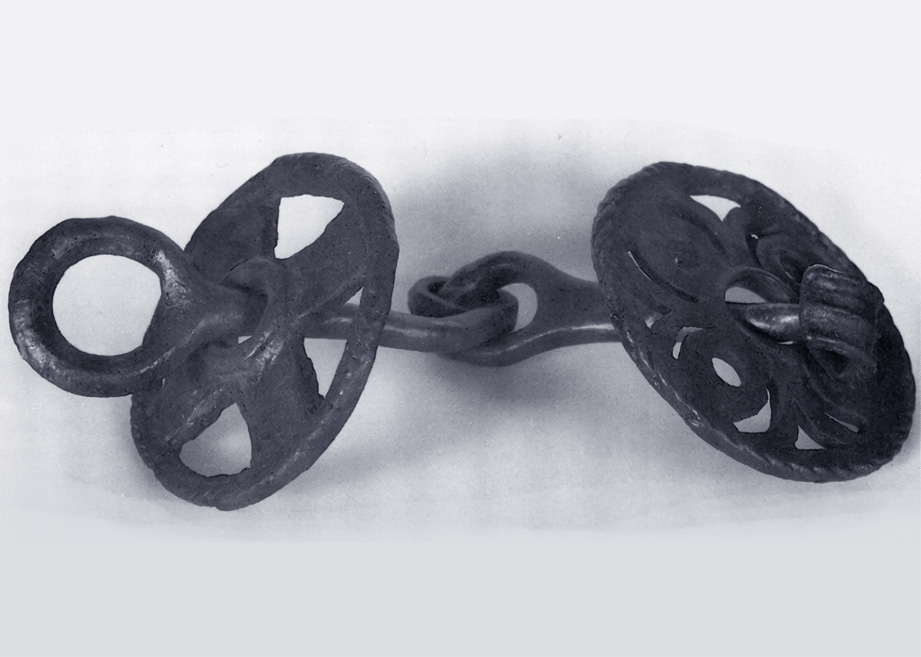
 War Horses – 4,500 years old
War Horses – 4,500 years old